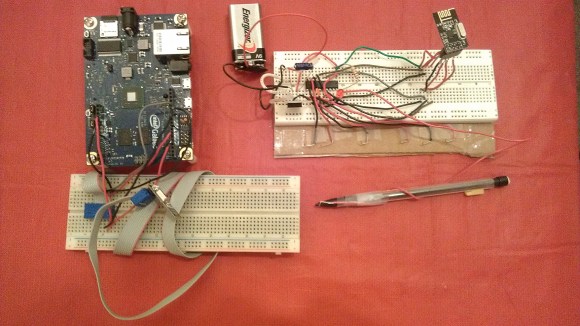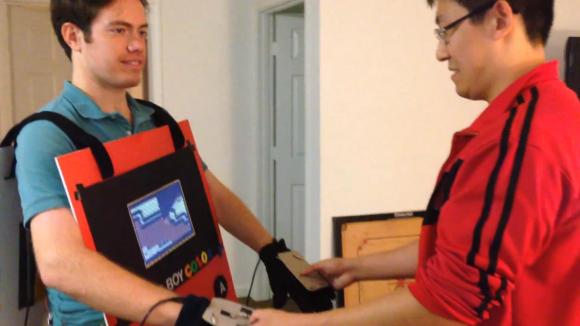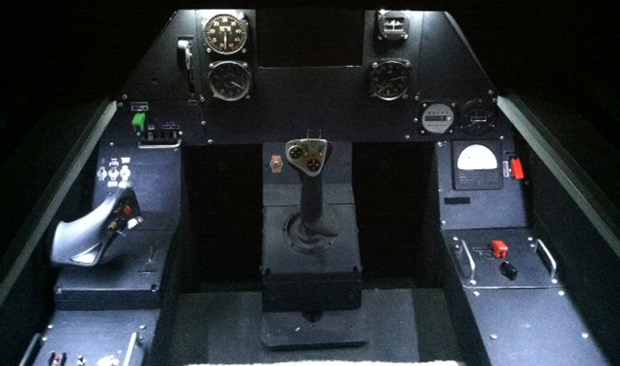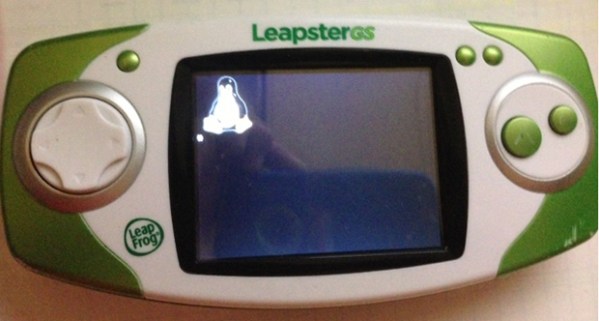 [Mark] recently finished his latest project, where he encrypts wireless communications between the new Intel Galileo and a Texas Instruments MSP430. The wireless interfaces used are the very common nRF24L01+ 2.4GHz transceivers, that had a direct line of sight 15 feet range during [Mark]’s tests. In his demonstration, the MSP430 sends an encrypted block of data representing the state of six of its pins configured as inputs. This message is then received by a sketch running on the Galileo and stored in shared memory. A python script then wakes up and is in charge of decrypting the message. The encryption is done using AES-128bits in Electronic Codebook mode (ECB) and semaphores are used to prevent simultaneous accesses to the received data. As it is the first project using an Intel Galileo we received, don’t hesitate to send us a tip if you found other ones.
[Mark] recently finished his latest project, where he encrypts wireless communications between the new Intel Galileo and a Texas Instruments MSP430. The wireless interfaces used are the very common nRF24L01+ 2.4GHz transceivers, that had a direct line of sight 15 feet range during [Mark]’s tests. In his demonstration, the MSP430 sends an encrypted block of data representing the state of six of its pins configured as inputs. This message is then received by a sketch running on the Galileo and stored in shared memory. A python script then wakes up and is in charge of decrypting the message. The encryption is done using AES-128bits in Electronic Codebook mode (ECB) and semaphores are used to prevent simultaneous accesses to the received data. As it is the first project using an Intel Galileo we received, don’t hesitate to send us a tip if you found other ones.
Why You Shouldn’t Care About The All-Metal 3D Printed Gun
Solid Concepts, one of the world’s largest rapid prototyping outfits, just printed a gun. Unlike previous 3D printed guns like the Liberator, this 3D printed version of an M1911 is made out of metal. It’s a real gun, with rifling in the barrel – something the Liberator doesn’t have – and has the look and feel of what the US military has been using as a service pistol for decades.
The Solid Concepts 1911 was made using the selective laser sintering process, using a combination of stainless steel and nickel-chromium alloys. Every single part of the gun, save for the spring, was 3D printed without any machining. It’s an impressive feat of rapid manufacturing – firing .45 ACP rounds, this gun will see 20,000 psi every time the gun is fired. It’s already chewed through a few magazines so far, and it apparently shoots pretty well, to boot.
Here’s why you shouldn’t care.
Solid Concepts business is to make things using rapid prototyping. They make everything from plastic baubles, tooling for injection molds, architectural models, and stuff that doesn’t get past the prototype stage. This 3D printed 1911 is simply a demonstration of Solid Concept’s capabilities, nothing more.
The printer used to manufacture this printer is an EOS SLS printer that costs many tens of thousands of dollars. Our limited research can’t pin the price of the printer down more than that, but let’s just say you could buy a very, very nice sports car for the same price, and we’re not talking about that awesome ‘vette down at the Chevy dealership.
This is just a neat little advertisement, that’s it. Someone at Solid Concepts realized if they made a gun using 3D printed parts, it would be picked up by blogs and wire services. They were right. It’s an excellent demo of what Solid Concepts’ capabilities are, but that’s just about it. You’re still not able to manufacture an M1911 on a desktop 3D printer, and even if you could, you could set up a machine shop in your garage and end up with a similar product for less money.
As an aside, and this is just me throwing an idea out there, can we please stop using guns as an example of what 3D printing can do? I respect your right to manufacture, own, and operate a gun, but as I write this paragraph, I’m cringing at the thought of all the pro and anti-gun comments this post will see.
If you’re looking for a way to demonstrate your 3D printing prowess, how about something like an engine? Given the right design, they’re more complicated than a gun, and a really small Wankel engine would be really cool.
Video of the Solid Concepts 1911 available below.
Continue reading “Why You Shouldn’t Care About The All-Metal 3D Printed Gun”
Linux On A Leapster For Classic Video Game Emulation
Christmas is coming, and if you have nieces, nephews, or ankle biters of your own roaming your house, you’re probably wondering how you’ll be subsidizing Santa this year. it looks like Toys R Us will be selling the Leapfrog LeapsterGS for $30 on Black Friday this year. It’s a Linux device running on a 550 MHz ARM 9, with 128 MB of RAM and 2 GB of Flash. Overpowered for a children’s toy, but perfect for when the kids forget about it in a month, because now you can replace the firmware with a proper Linux install and run classic emulators.
Putting Linux on these cheap handhelds made for children isn’t anything new; we’ve seen it done with the Leapfrog DIDJ and the Leapfrog Explorer. Those consoles, however, had rather anemic CPUs and not a whole lot of RAM. Moore’s Law finally kicked in for stocking stuffers, it seems, and the Leapster GS is powerful enough to play all those Nintendo, Game Boy and even MAME games.
All that’s needed to flash the new firmware is soldering a few wires onto the LeapsterGS’ board for a serial connection. The new LeapsterGS firmware even has an MP3 and movie player, so even if the recipient of one of these machines grows tired of it in a week, there’s still a lot of life left in it.
Video of the LeapsterGS playing the greatest arcade game below.
Continue reading “Linux On A Leapster For Classic Video Game Emulation”
3D Printing With Metal… At Home!
[Bam] from the LulzBot forums has successfully printed metal using his 3D printer and a Budaschnozzle 1.1 hot end. Well, solder to be specific — but it’s still pretty awesome!
He’s making use of 3mm solder purchased from McMaster (76805a61), which has a blend of 95.8% tin, 4% copper and 0.2% silver. It took quite a few tries to get it extruding properly, and even now it seems to only be able to print about 15mm before jamming up — a more specific hot end with a larger thermal mass might help. He plans on trying a thinner filament (1.75mm) as it might help to keep it at the proper extrusion temperature, which in this case is around 235C.
During our research we found another user from the RepRap blog who has also been experimenting with printing low-melt point alloys — and he’s even successfully created an Arduino compatible Sanguino board using the printer!
If you want to try this yourself, you’ll need a nozzle you don’t care about, bored out to about 1mm — any smaller and it won’t extrude at all. Be warned though, the solder will corrode brass and aluminum, and [Bam] notes that after going through 1lb of solder, the nozzle was closer to 2mm in diameter when he was done! Oh and for the love of hacking — use ventilation!
Stick around after the break to watch a video on a professional version of this system — which is essentially a repurposed welding robot, using electron beam direct manufacturing. These technologies can’t make nicely finished parts, but they excel when considering they can make near net-weight parts, requiring only a small amount of machining to finish.
GameBoy Color Costume

Okay, okay. We know it’s November now, but when [John] sent this project in, we just had to share it. He made a fully functional Gameboy Color costume!
The costume makes use of a Raspberry Pi (located on his back), running RetroPie, which is an open source project dedicated to creating a universal console emulator. To create the controllers he used two Teensy microcontrollers in his gloves, setup to emulate two USB keyboards on the Pi. Since he’s using Teensy 3.0, it supports capacitive touch sensing, so all he had to do was wire pieces of aluminum to the input pins to create touch-sensitive metal buttons on the gloves. He then slapped a cheap 10″ LCD from Adafruit onto his chest, stuffed a few 12V LiPo batteries in his pockets, and was ready to be the hit of any party he went to.
The costume was a great success, although a pesky pair of Mario and Luigi kept holding his hands all night… Stick around after the break to see a demonstration video!
Remote Control FPV Cockpit

FPV flying, for how awesome it actually is, still consists of fiddling around with a remote control transmitter and either wearing video goggles or squinting into a screen. Awesome, yes, but not as cool as [Brett Hays]’s enclosed cockpit ground station. It’s a trailerable flight sim that allows you to have the same experience of flying an aircraft over your local terrain without actually leaving the ground.
The centerpiece for this build is a 42 inch flat screen TV that was picked up for $160. This was placed at the front of a large plywood and 2×2 box along with a computer joystick, throttle, and rudder controls.
The pots inside the controls needed to be switched out to match the resistance of the ones inside an old Futaba transmitter. From there, completing the the cockpit was just a matter of fabricating a few panels for a video switcher, gear retract lever, flaps. and RC radio settings.
It’s a truly amazing build and when placed on a trailer towed by [Brett]’s jeep, has the potential to be the closest thing to flying a manned aircraft you can get without a pilot’s license.
Videos of the cockpit in action below.
The Tiniest Video Game
As we read [Adam]’s writeup for an extremely tiny video game system through coke bottle glasses, we’re reminded of the countless times we were told that sitting, ‘too close to the Nintendo’ would ruin our eyes. We’ll happily dismiss any article from a medical journal that says there was any truth to that statement, but [Adam]’s tiny video game system will most certainly hurt your eyes.
A few years ago, Atari sold keychain-sized joysticks that contained classics such as Pong, Breakout, Centipede, and Asteroids. [Adam] apparently ran into a cache of these cool classic baubles and immediately thought of turning them into a stand-alone video game system.
For the display, [Adam] used a CRT module from an old Sony Handicam. These modules had the right connections – power, ground, and composite video input – to connect directly to the Atari keychain games. The result is a video game that’s even smaller than a postage stamp. The picture above shows the tiny CRT next to a 25mm postage stamp; it’s small by any measure.














